Circle 3 – Yujie
Posted: May 1, 2022 Filed under: Uncategorized Leave a comment »In circle 3, I kept the key ideas and media design developed during circle 1 and 2. Two things are still central to my project. The first one is to use fragmented body parts of the culturally marked dancer to resist the idea of returning to the whole which represents the so-called cultural essence. The whole is also easy to be categorized into racial stereotypes. The fragmented body parts then can be seen as a challenge. The second part is to continue offering the negative mode of seeing. The inverted color (or the negatives) can be seen as a metaphor for undeveloped images or hidden “truth” in the darkroom for one to see differently.
I also added two things in the final circle: the preshow projections and the voice-over from my interview with the dancer. From the feedback after the showing, I receive helpful comments from the class for these two add-ons. I was told that they appreciate that the preshow projections allow them to explore the space and the circular setting forms a more intimate relationship between the dancer and the viewer. Also, the contradictions of performing the Japanese body discussed in the voice recording have some guiding effect for the viewer to get my intention.
Here are some Isadoro patches
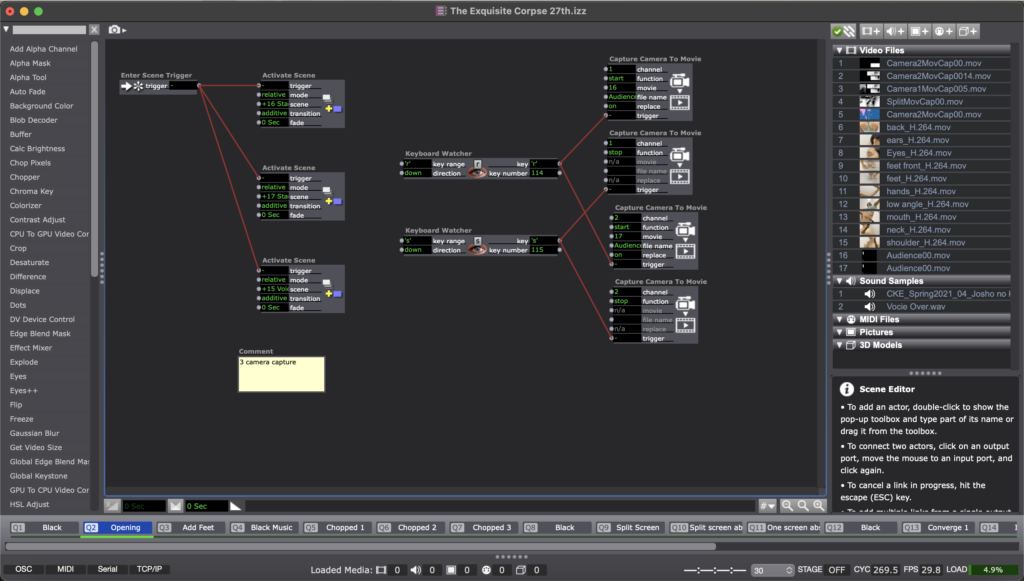
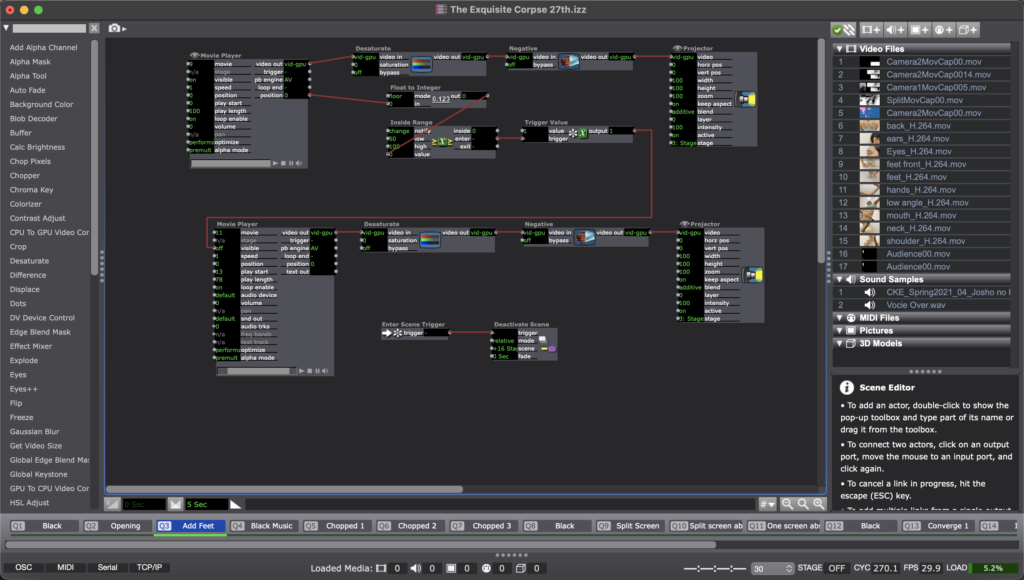
Here is the video document of the final performance
Circle 2 – Yujie
Posted: April 8, 2022 Filed under: Uncategorized Leave a comment »For the circle 2, I was going to add the composition of multiple projection screens and audience interaction.But I spent too much time on some technical issues. I end up having little progress on these two things. But I did try something new. I add a viewing experience that aims at defamiliarizing what we see every day as “real” experience. Especially, when we perceive things according to already-made categories. I ask the viewers to invert their iPhone to negative mode. Then they can choose to (or not) use their negative mode camara to see the performance. When they look at the dancer, they will see that she is invert to negative, while when they look at the projection (parts of the body in negative), they will see the normal images. I hope that in consistently seeking to “see”, the viewers will reflect on their own subjective viewing experience and on what they can really “see.”
Here is the recording of the circle 2 showing:
For the circle 3, I will continue what I have left from circle 1 and I will add voice recording of the dancer
1. Develop multiple projections
2. Audience presence in the performance
3. voice recording of the dancer
Circle 1-Yujie
Posted: March 24, 2022 Filed under: Uncategorized Leave a comment »My final project is to collaborate with my dancer Yukina who is working on a restaging project. She is going to restage Japanese contemporary choreographer Saeko Ichinohe’s piece and then create her own piece responding to Ichinohe’s work. I’m working with her to create the mediation for her own choreography.
We center our project around one question that is derived from Yukina’s own lived experience. Why people in the US expect her, a Japanese woman, to perform and embody Japanese cultural elements on stage. I’m inspired by Rachel Lee’s book The Exquisite Corpse of Asian American. Lee thinks that certain Asian American artists use fragmented body parts to resist the idea of returning to the whole which represents the so-called cultural essence. The whole is also easily to be categorized into racial stereotypes. The fragmented body parts then can be seen as a challenge.
In my circle 1, I use live camera to capture dancer’s body parts and frame it in discrete space on the projection. I also use Isadora to capture the performance in real time and juxtaposition the recording with the real-time performance. Dancers’ body is not just divided in space but also in time. Then, I use video effects to present dancer’s inner state. In the end, I try to put all the fragmented body parts randomly together, but it was not successful in this circle.
Here is one scene in Isadora:
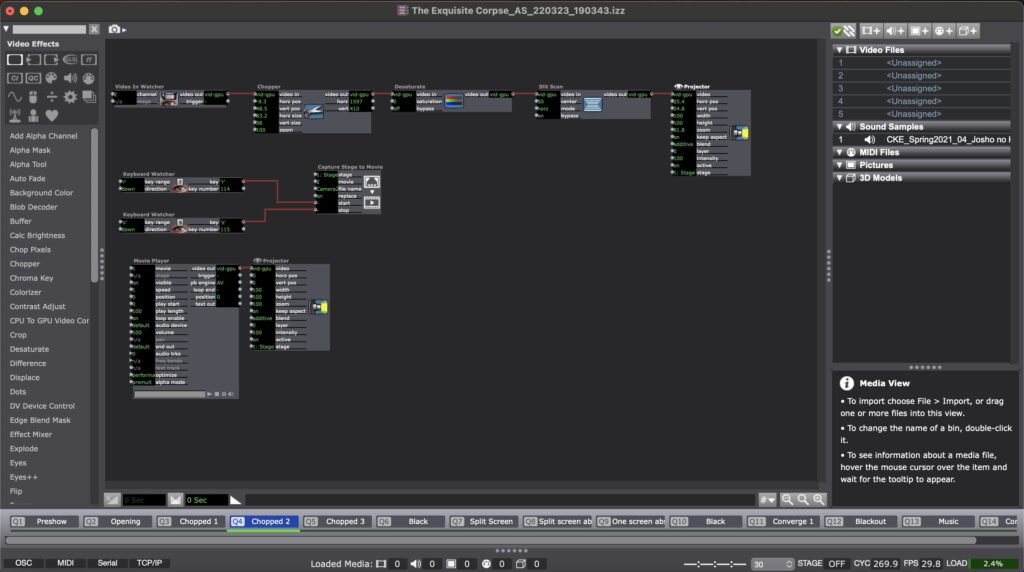
Here is the video documentation of my circle 1:
For my circle 2, I’m thinking of the following development:
- Use two cameras to free my laptop. Work on camera angles to really get close to the dancers’ body
- Develop a version of the surrealist game that invite a more dynamic participation from the audience. I might consider adding the Kinect to include the audience’s motion, so that they are not just gaze into the dancer’s body.
- Consider more possibilities of the projection. I want to try different ways to devise the space with the projection.
Pressure Project 3 – Yujie
Posted: March 3, 2022 Filed under: Uncategorized Leave a comment »The pressure project 3 asks us to use audio to tell a story that is related to our cultural origin. This is a broad prompt. I’m a Chinese who live in the United States and I feel cultural differences in the daily bases. But when it comes to tell a significant story, I still feel like no way to start. So, I just spent a few days for brainstorming. Even though I didn’t do anything in the first few days, I became very sensitive to culture related elements. I was preparing my presentation for one of my research papers that studies a Chinese queer dancer. So, it just came to me that I can just tell a story based on my research. One of the dancer’s pieces has historical and contemporary references to a Chinese female legend, Yu Ji. Her story has been told in numerous cultural works of literature, film, opera, and performance. She would be a perfect example for telling the changing gender and sexual ideals and norms in Chinese history.
I decided to use visual clips along with the audio because I try combine four diverse sources from distinct historical period. The videos will help the audiences grasp a rather complicated story. I downloaded videos and sounds from the internet and record my own written script that tells a combined story.
Here is the screen shots of my voice-recording:
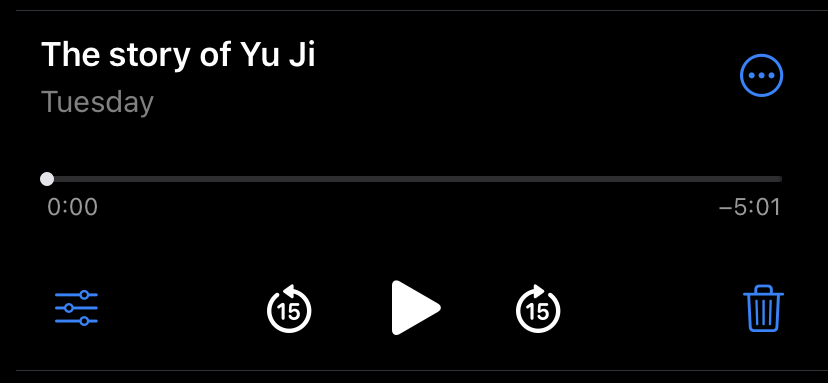
Here is the final video-audio project:
Pressure project 2 – Yujie
Posted: February 22, 2022 Filed under: Uncategorized Leave a comment »This pressure project asks us to use Isadora and Makey Makey to reveal a secret. I was struggling for a long time about how to define a secret that can be connected to physical forms that conduct electricity. First, I was thinking about the things that are serious, epic, or hidden in daily lives. But those things are really hard to connect with daily objects that could animate Makey Makey. However, it hits me in the last class where Alec said that the secret can also be something that is delightful and small. These comments then reminded me of something I find delightful myself. I couldn’t stop watching the funny and silly videos where people use various materials and ideas to make Bing Dwen Dwen, the mascot of the 2022 Beijing winter Olympics. Because of its surging popularity and unexpected shortage of supply, people can’t get the mascot even after waiting for long hours. So, they started to make all sorts of creative and personalized versions of Bing Dwen Dwen. I was so amazed by people’s creativity and exceptional skills. I think my class would be also fascinated by these grassroots creations.
I first download and edit the news videos about how cute and popular Bing Dwen Dwen is to give some context for people who don’t really watch the Winter Olympics. Then I use text draw to give directions to the class that you can actually get one if you follow the process. By holding the “I” button with one hand and pressing one of the drawings with the other hand, the earth and output of the Makey Makey will be connected through the human body and the pencil graphite. Then different videos of Bing Dwen Dwen creation will be triggered to display.
The four options are represented on a paper with pencil drawings. The four drawings have some elements related to the video so that they can trigger some imagination and lead people to reveal the secrets behind them. After one of them is revealed, the display will always go back to the selection scene for the next revelation.
Here is the main Isadora scene of trigger connection between videos and drawings.
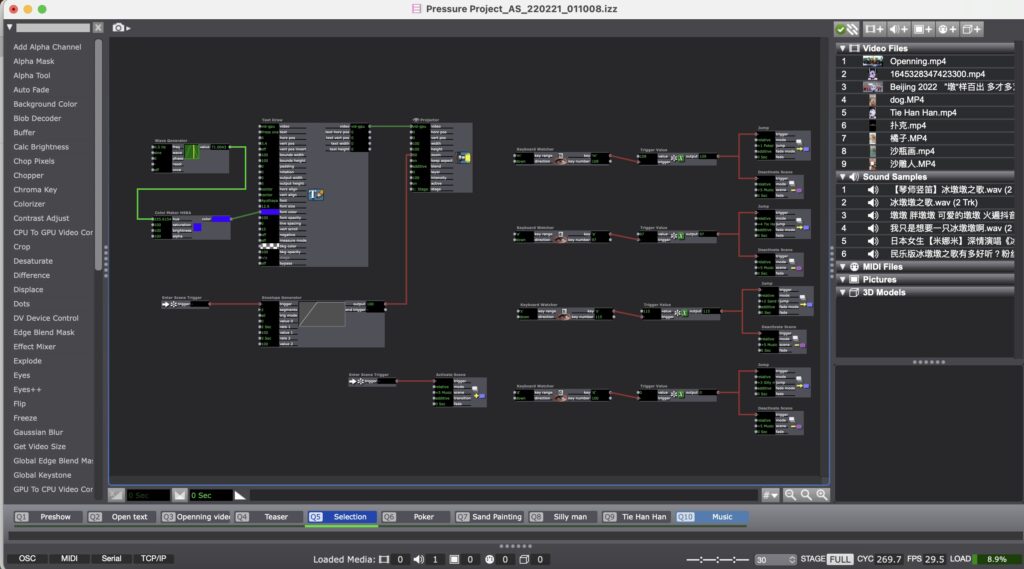
Picture of connection

Pressure Project 1 – Yujie
Posted: January 27, 2022 Filed under: Uncategorized Leave a comment »When I see the key words “traffic” and “congestion” in pressure project instruction, the first thing come to my mind is the intersections on the street. Because English is my second language and my learning experience of those two words when I was young restrict me from thinking broadly and metaphorically. Though I realized that I limit myself to the narrow concept of traffic and congestion, the pressure time frame stops me from trying to do the process again. So I decide to follow what I have already chosen, which is an intersection on the High Street. One thing I’ve got from this experience is that we should always think twice about the descriptive language itself and be aware of any cultural or experiential bias we might have around it.
Here is a top-down diagram I have drown:

I’m using AEIOU framework from the week 1 readings to organize information I observed in a high traffic congestion on the intersection of the N High St. and E Hubbard Ave. at night in the weekend. AEIOU stands for Activities, Environments, Interactions, Objects, and Users.
Activities: pedestrians passing across E Hubbard Ave; vehicles moving from E Hubbard Ave. into N High St. and vise versa.
Environments: the intersection located in busy venues of bar and restaurant on Short North. During the weekend after about 10pm, partygoers are packed on the high street. There is a high traffic congestion on E Hubbard Ave where cars try to turn right of left into High St.
Interactions: Drivers coming from E Hubbard Ave encounter the traffic lights, avoid pedestrians walking across the street, and yield drivers on the High Street; drivers on high street move on normal speed; pedestrians encounter traffic light.
Objects: there is a traffic lights for pedestrians to cross the street; another traffic light is for vehicles coming from E Hubbard Street.
Users: drivers on the E Hubbard Street who experience congestion during the traffic peak hour at night on the weekend.
Problem: drivers coming from E Hubbard Street experience congestion because they have to wait for pedestrians to cross and have to yield drivers on the high street coming from both directions. The left turn traffic light only turn to green circle instead of greet arrow, so drivers have to wait for a long time until both direction are clear. This might not a problem during non-peak time, say weekdays or daytime.
Intervention: I suggest building a congestion senser on the right side of E Hubbard Street to track the congestion. The senser can be something like the kinetic senser which is sensitive to the movement of vehicles. If there is a stop of vehicle movement and it last for about more than 1 minutes, the senser will trigger the traffic light on High Street to turn to green arrow instead of green circle. The senser can be only turned on during the weekend at 10pm-1am.
See the photo below:
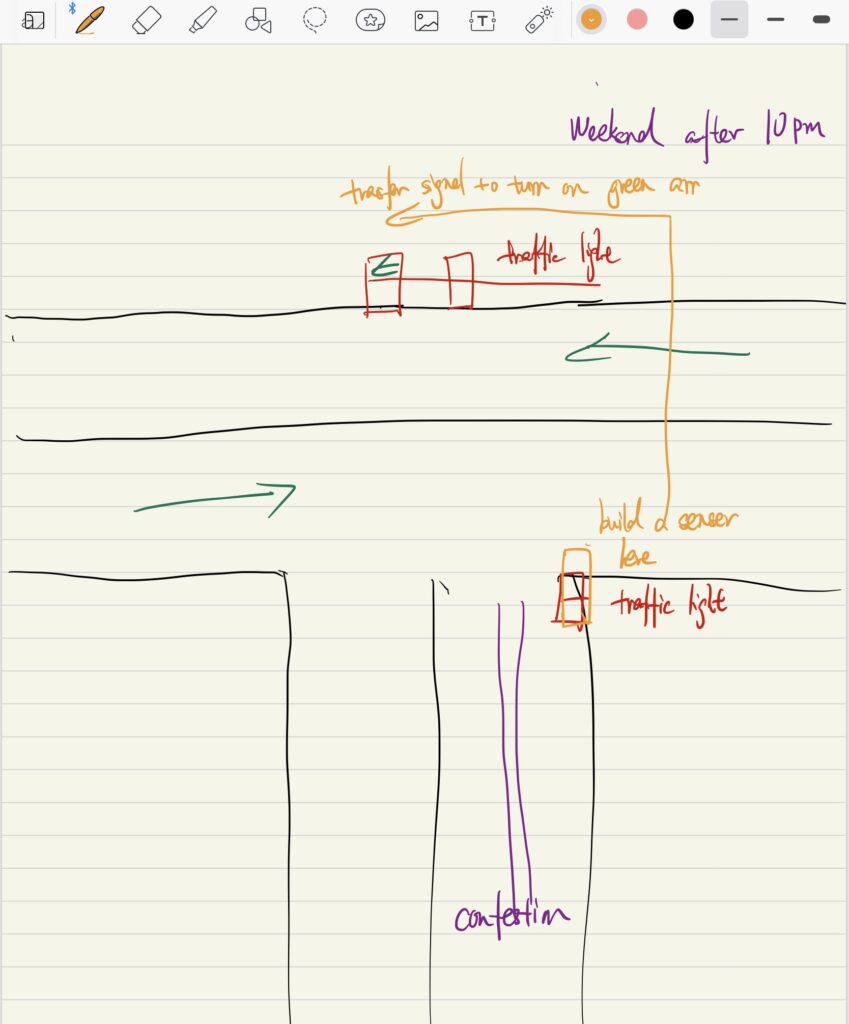
Project Pump
Posted: January 25, 2022 Filed under: Uncategorized Leave a comment »https://dems.asc.ohio-state.edu/wp-admin/post.php?post=2214&action=edit
I find this dancing club project very interesting. One of the reasons that I choose this project is to see what are the possibilites of devising experiential dancing body that are already explored. I like the idea of connecting the virtual body and physical boby as well as the virtual space and theater conventions. The funny little twist here is that people get ticket in a box office to be the performers themselves. The whole interactive process is orgnized by a stucture that dictate people to move in certain way but finally failed at some point. The author’s realization that people are uncontrollabe tells us something about the slippage of the intentional devising concerning human experience.